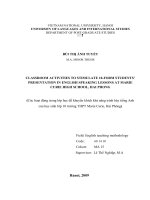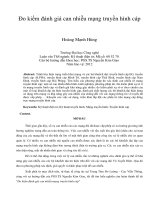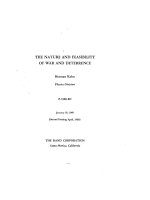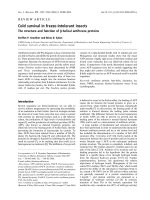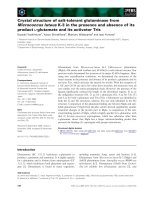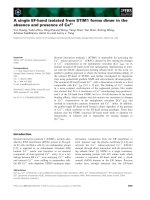teachers’ beliefs in the necessity and feasibility of fostering learner autonomy in efl learning writing at phuoc kien high school
Bạn đang xem bản rút gọn của tài liệu. Xem và tải ngay bản đầy đủ của tài liệu tại đây (1.19 MB, 127 trang )
MINISTRY OF EDUCATION AND TRAINING
HO CHI MINH CITY OPEN UNIVERSITY
__________________________________
NGUYEN THI PHUC TRINH
TEACHERS’ BELIEFS IN THE NECESSITY AND FEASIBILITY
OF FOSTERING LEARNER AUTONOMY IN EFL LEARNING
WRITING AT PHUOC KIEN HIGH SCHOOL
MASTER OF ARTS IN TESOL
HO CHI MINH CITY, 2019
MINISTRY OF EDUCATION AND TRAINING
HO CHI MINH CITY OPEN UNIVERSITY
__________________________________
NGUYEN THI PHUC TRINH
TEACHERS’ BELIEFS IN THE NECESSITY AND FEASIBILITY OF
FOSTERING LEARNER AUTONOMY IN EFL LEARNING
WRITING AT PHUOC KIEN HIGH SCHOOL
Major: Teaching English to speakers of other language
Major code: 60140111
MASTER OF ARTS IN TESOL
Supervisor: LE THI THANH THU, Ed.D.
Ho Chi Minh City, 2019
i
STATEMENT OF AUTHORSHIP
I certify that this thesis entitled “Teachers’ Beliefs in the Necessity and
Feasibility of Fostering Learner Autonomy in EFL Writing Learning at Phuoc Kien
High School” is my own work.
Except where reference is made in the text of the thesis, this thesis does not
contain material published elsewhere or extracted in whole or in part from a thesis by
which I have qualified for or been awarded another degree or diploma.
No other person’s work has been used without due acknowledgement in the main
text of the thesis. This thesis has not been submitted for the award of any degree or
diploma in any other tertiary institution.
Ho Chi Minh City, 2019
NGUYEN THI PHUC TRINH
ii
ACKNOWLEDGEMENTS
This Master of Arts in TESOL thesis is the result of a fruitful collaboration of all
the people who have kindly contributed with enormous commitment and enthusiasm in
my research. Without the help of those who supported me at all times and in all possible
ways, it would not have been feasible for me to complete my M.A. thesis.
First of all, I am deeply indebted to my supervisor, Le Thi Thanh Thu Ed.D.,
whose compassion; encouragement and guidance throughout the research have helped in
the completion of this thesis. I have truly learned from the excellence of her skills and
from her wide experience in research; no words are adequate to describe the extent of my
gratitude.
I am also sincerely grateful to all lecturers of the Open University in Ho Chi Minh
City for providing me with invaluable sources of intellectual knowledge during my study
there. This knowledge was very useful when I conducted this research.
I would like to thank my TESOL friend, namely M.A. Truong Minh Hoa, who
shared his constructive opinions and comments on my thesis.
I owe a great debt of gratitude to the anonymous participants who contributed data
to this thesis. Without them the data collection for this study could not properly been
carried out.
Last but not least, I would like to express my particular gratitude to my beloved
family for their understanding, encouragement, and spiritual support over time and
distance.
iii
ABSTRACT
As proven by research, high school students usually rely on their teachers in their
writing learning; consequently, this passive involvement hinders their writing
performance. Thus, it is necessary to develop learner autonomy in writing learning. In
another line, language students’ low writing performance could be partly due to the effect
of the teachers’ beliefs about writing and its teaching.
The study was conducted to explore the teachers’ beliefs about the necessity and
feasibility of developing learner autonomy in writing learning among Phuoc Kien high
school students.
Six EFL teachers at Phuoc Kien high school reflected their beliefs via the semistructured interview with nine questions.
Firstly, the results showed that all the teachers fully recognized the necessity of
building up learner autonomy in writing learning highly appreciated potential values of
fostering learner autonomy in writing learning. Secondly, the findings also pointed out
that only a half of the teachers positively viewed that fostering learner autonomy in
writing skill at Phuoc Kien high school was feasible to some extent, while the other half
was skeptical about its feasibility. In specific, the teachers elucidated the advantages and
barriers in fostering learner autonomy in EFL writing learning based on three aspects of
teachers’ roles, learners’ responsibilities and schooling environment.
Based on the findings, some implications were made for the teachers and the
further study in the realm of fostering learner autonomy in writing development.
iv
TABLE OF CONTENTS
Page
STATEMENT OF AUTHORSHIP………………………………………………..
i
ACKNOWLEDGMENTS……………………………………………………….....
ii
ABSTRACT ………………………………………………………………………..
iii
TABLE OF CONTENTS ………………………………………………………….
iv
LIST OF FIGURES ………………………………………………………………..
viii
LIST OF TABLES ………………………………………………………………...
ix
LIST OF ABBREVIATIONS …………………………………………………….
x
Chapter 1: INTRODUCTION ……………………………………………………
1
1.1. Background to the study ……………………………………………………..
1
1.2. Problem statement ……………………………………………………………
3
1.3. Research questions ……………………………………………………………
4
1.4. Significance of the study ……………………………………………………...
5
1.5. Thesis outline ………………………………………………………………….
6
Chapter 2: LITERATURE REVIEW ……………………………………………
7
2.1. Teachers’ beliefs ………………………………………………………………
7
2.1.1. Definition of teachers’ beliefs ……………………………………………
7
2.1.2. Categories of teachers’ beliefs ……………………………………………
7
2.1.2.1. Beliefs in learners…………………………………………………...
8
2.1.2.2. Beliefs in self ………………………………………………………..
8
2.1.2.3. Beliefs in teaching and learning ……………………………………
9
2.1.3. Sources of teachers’ beliefs ………………………………………………
9
2.2. The definition of learner autonomy ………………………………………….
10
2.3. Characteristics of an autonomous learner …………………………………..
12
2.4. Necessity of fostering learner autonomy …………………………………….
13
2.5. Feasibility of fostering learner autonomy ……………………………………
14
2.5.1. Teachers’ roles ……………………………………………………………
14
v
2.5.2. Students’ responsibilities ………………………………………………….
16
2.5.3. Schooling environment ……………………………………………………
17
2.5.4. Approaches to fostering learner autonomy ……………………………….
18
2.5.4.1. Curriculum-based approach ………………………………………...
18
2.5.4.2. Technology-based approach ………………………………………...
19
2.5.4.3. Learner-based approach …………………………………………….
19
2.6. Teaching and learning writing within learner autonomy development …...
20
2.6.1. Natures and levels of writing ……………………………………………...
20
2.6.1.1. Natures of writing ………………………………………………………….
20
2.6.1.2. Levels of writing ……………………………………………………………
20
2.6.2. Approaches to teaching writing …………………………………………..
21
2.6.2.1. Product approach …………………………………………………………
21
2.6.2.2. Process approach …………………………………………………………
21
2.6.2.3. Genre-based approach ……………………………………………………
22
2.6.3. Peer feedback in writing …………………………………………………..
22
2.6.4. Portfolio …………………………………………………………………...
23
2.6.5. Self-regulated learning ……………………………………………………
23
2.7. Previous studies ………………………………………………………………..
25
2.8. Research gaps ………………………………………………………………….
27
2.9. Chapter summary ……………………………………………………………..
28
CHAPTER 3: METHODOLOGY ………………………………………………...
29
3.1. Overall research approach ……………………………………………………
29
3.1.1. Research design …………………………………………………………..
29
3.1.2. Research procedures ………………………………………………………
29
3.1.3. The sample ………………………………………………………………..
30
3.2. Research setting and participants ……………………………………………
30
3.2.1. Research setting ………………………………………………………….
30
3.2.1.1. Context ………………………………………………………………………
30
vi
3.2.1.2. Materials ……………………………………………………………………
31
3.2.1.3. Writing section …………………………………………………………….
32
3.2.2. Research participants …………………………………………………….
33
3.3. Description of the interview …………………………………………………..
35
3.3.1 Rationale to interview ………………………………………………….....
35
3.3.2. Description of the interview ……………………………………………...
35
3.4. Interviewing procedure ……………………………………………………….
37
3.5. Data analysis …………………………………………………………………...
38
3.6. Validity and reliability ………………………………………………………..
39
3.7 Summary ……………………………………………………………………….
40
CHAPTER 4: DATA ANALYSIS AND DISCUSSIONS ………………………..
41
4.1. Research question 1 …………………………………………………………...
41
4.1.1. The teachers’ overall understandings of learner autonomy ………………
41
4.1.2. The teachers’ perceptions of an ideal autonomous learner ……………….
44
4.1.3. The teachers’ beliefs on the necessity of fostering learner autonomy in
writing learning ……………………………………………………………
49
4.1.4. The teachers’ beliefs on benefits of promoting learner autonomy in
writing learning ……………………………………………………………
52
4.2. Research question 2 …………………………………………………………...
54
4.2.1. The teachers’ beliefs on the feasibility extent of fostering learner
autonomy in EFL writing learning ………………………………………
55
4.2.2. The teachers’ beliefs on the advantages in fostering learner autonomy in
writing learning ………………………………………………………….
58
4.2.3. The teachers’ perceptions of the barriers in fostering learner autonomy in
EFL writing learning …………………………………………………….
62
4.2.4. Teachers’ perspectives on the teacher roles adapted to foster learner
autonomy in writing learning …………………………………………….
4.2.5. Teachers’ perspectives on the activities implemented to foster learner
68
vii
autonomy in writing learning …………………………………………….
72
4.3. Chapter summary ……………………………………………………………..
76
CHAPTER 5: CONCLUSIONS AND RECOMMENDATIONS ………………
77
5.1. Conclusions …………………………………………………………………….
77
5.2. Recommendations …………………………………………………………….
79
5.3. Limitations …………………………………………………………………….
81
5.4. Suggestions for further study …………………………………………………
81
REFERENCES …………………………………………………………………….
82
APPENDICES………………………………………………………………………
92
APPENDIX A.1: INTERVIEW PROTOCOLS (ENGLISH VERSION) ……...
93
APPENDIX A.2: INTERVIEW PROTOCOLS (VIETNAMESE VERSION)…
94
APPENDIX B.1: TRANSCRIPT 1 (Interviewer-F1) ……………………………………
95
APPENDIX B.2: TRANSCRIPT 2 (Interviewer-F2) ……………………………………
98
APPENDIX B.3: TRANSCRIPT 3 (Interviewer-F3) ………………………………….
101
APPENDIX B.4: TRANSCRIPT 4 (Interviewer-F4) ……………………………
104
APPENDIX B.5: TRANSCRIPT 5 (Interviewer-M5) …………………………...
108
APPENDIX B.6: TRANSCRIPT 6 (Interviewer-F6) …………………………………...
112
viii
LIST OF FIGURES
Page
Figure 3.1: The research procedures ………………………………………………. 29
ix
LIST OF TABLES
Page
Table 2.1: Teachers’ roles in fostering learner autonomy (Synthesized works)…….
15
Table 2.2: Text types of writing sections …………………………………………………
33
Table 3.1: Demographical information of participants …………………………….
34
Table 4.1: The teachers’ overall understanding of learner autonomy ……………..
42
Table 4.2: The teachers’ overall perceptions of an ideal autonomous learner …….
45
Table 4.3: The teachers’ beliefs on the necessity of fostering learner autonomy in
49
writing learning …………………………………………………………
Table 4.4: The teachers’ beliefs on benefits of fostering learner autonomy in
52
writing learning …………………………………………………………
Table 4.5: The teachers’ beliefs in the feasibility extent of fostering learner
55
autonomy in EFL writing learning ……………………………………...
Table 4.6: The teachers’ beliefs on the advantages in fostering learner autonomy
58
in writing learning ………………………………………………………
Table 4.7: The teachers’ perceptions of the barriers in fostering learner autonomy
63
in writing learning ………………………………………………………
Table 4.8: Teachers’ perspectives on the teacher roles adapted to foster learner
68
autonomy in writing learning ……………………………………………
Table 4.9: Teachers’ perspectives on the activities implemented to foster learner
autonomy in writing learning ……………………………………………
72
x
LIST OF ABBREVIATIONS
EFL
: English as a Foreign Language
ELT
: English Language Teaching
F
: Female
GCSE
: General Certificate for Secondary Education
ICT
: Information and Communication Technologies
M
: Male
M.A.
: Master of Arts
MOET
: Ministry of Education and Training
TESOL
: Teaching English to Speakers of Other Languages
1
Chapter 1
INTRODUCTION
1.1.
Background to the study
New approaches have been always emerging in English teaching realm, there is
a trend to attribute learners to passive receivers of new information. Traditionally, the
teacher plays the authority as a source of knowledge. However, it is imperative that the
roles of the teachers and learners be urgently modified. In specific, a teacher should
provide the students with appropriate strategies and opportunities for their active
practice in the language classrooms. Supposed that the teachers are willing to change
and shift classroom atmosphere from teacher-centered to learner-centered pedagogy, a
teacher‟s responsibility is to facilitate the change. At that time, the students become
more autonomous (Holec, 1981, p. 3).
Indeed, learner autonomy in English education has received great concern from
numerous researchers around the world (e.g. Benson, 2007; Benson, 2011; Little, 2007;
Littlewood, 1996). The development of learner autonomy is seen as one of the most
important educational goals and as “one of the key competences for lifelong learning”
(European Commission, 2006, as cited in Vázquez, 2014, p. 59). Inferentially, so as to
be good residents in the knowledge-based community of the existing 21st century,
students need to heavily rely on their own inquiries.
In spite of the immerse unity on the importance and positive results of learner
autonomy, it still appears scant to many foreign language classrooms, especially in
Asian contexts. By typical reason, Little (1991) assumes some arguments that the
teachers have against fostering autonomy and difficulties they have to face during
trying to foster autonomy among learners like the curriculum, exams and subject
content as well. Regardless of these false fears, fostering learner autonomy in the
2
foreign language classroom requires a process of change whereby we shift from a
teacher-centered approach to a more learner-centered approach. Under learner
autonomy pedagogy, according to Raya and Fernández (2002), learners should be
allowed to take control of their own linguistic and learner development in a transition
from teacher-control to learner-control. Little (1991) enumerates two key benefits of
approaching learner autonomy in language classrooms. Firstly, the students have
chances of participating in decision-making process. Secondly, once the students
become more autonomous and active for their learning, it is reckoned that they will be
an effective unit of the society.
Pertaining to the teacher role, Tudor (1993, as cited in Al-Asmari, 2013)
suggests that teachers who provoke learner autonomy perform their role differently
such as a facilitator and support in order that they help students to take the own
responsibility. As teachers play such a critical role in fostering learner autonomy, their
beliefs have also become a key concern in education (Le Van Canh, 2011, p. 64). This
may originate from the view that “teachers‟ beliefs influence their goals, procedures,
materials, classroom interaction patterns, their roles, their students” (Kuzborska, 2011,
p. 122). Therefore, Richards, Gallo and Renandya (2001) confirm that to understand
how teachers approach their work, the beliefs and principles they operate from should
be understood. Indeed, teachers‟ beliefs in language education have been receiving an
increased concern from educational researchers and extensively discussed in literature
since the 1970s, significantly contributing to the exploration of teachers‟ beliefs, and
the relationship between teachers‟ beliefs and practices (Zheng, 2009; Shinde &
Karekatti, 2012). To put it different, exploration of teachers‟ pedagogical beliefs is
vitally conducive to our understanding of their planning, instructional decisions, and
classroom practices.
3
1.2.
Problem statement
Profoundly influenced by Confucian perspective, teaching and learning English
in Vietnamese context is traditionally generated by the core mission of the teachers is
to transmit the knowledge to their students rather than orienting students to become
independent in their learning (Nguyen Thanh Nga, 2014). In the same vein, Tran Thi
Ly (2007) problematized that in Vietnamese high school context, students are
automatically attributed to passive receivers of language knowledge rather than
language construction while the teachers tend to be powerful centers of the English
classrooms. Inferentially, Vietnamese schools are framed in a solid skeleton of which
the authority is not diffused; at the same time, interdependence and activeness are less
noticed. Consequently, the students seem not to be fostered their learner autonomy
during this educational system.
In fact, in these days, Asian students are no longer passive listeners but expect
to be more active and autonomous, which was ultimately found from the study of
Littlewood (2000). However, Pham Thi Hong Thanh (2008) reveals a dilemma that in
many Vietnamese educational settings, “Vietnamese teachers are not happy to transfer
their roles as a knowledge transmitter to a learning facilitator” (p. 3). In particular, for
students to be effective members of today‟s knowledge-based community, it is
recommended that the high school teachers should stimulate students to identify the
objectives, to seek the contents and progressions, to opt learning strategies, to monitor
the path of language acquisition and to evaluate what has been acquired so far (Holec,
1981). On the other hand, students need to be more sensitively responsible for their
learning with the help and orientation from their teachers.
Specific to learning and teaching English writing skill at the Vietnamese high
school context, according to what Vietnamnet (2016) has reported, many candidates of
the 2016 National GCSE (General Certificate for Secondary Education) examination in
4
Ho Chi Minh City either did not complete their writing section in time or skipped it.
Some students revealed that they found writing section really difficult. In addition,
others admitted that because of learning some sample texts which were provided by
their teachers by rote, when the topic in the writing section had a little change, they
could not manage it. It is interpreted that most high school students do not know how
to do free writing, and they do not handle the strategies for composing texts
independently but actually practice writing in a controlled and passive way. In another
point, as prescribed by Ho Chi Minh City Department of Education and Training, high
school teachers are granted rights and commissions to get high school students more
active and autonomous in their language acquisition, including writing skill in
particular. Therefore, it is necessary to develop learner autonomy in writing learning.
In another line, as what Khanalizadeh and Allami (2012) said, students‟ low writing
performance and that writing is the least developed language skill could be partly due
to the effect of the teachers‟ beliefs about writing and its teaching. Thus far, it was
necessarily important for the researcher to explore high school teachers‟ beliefs on
fostering their high school students‟ autonomous learning of writing skill at Phuoc
Kien high school, Nha Be district.
1.3.
Research questions
Carried out at Phuoc Kien High School (Nha Be District, Ho Chi Minh City),
the purpose of the current study was to explore the teachers‟ beliefs about the necessity
and possibility of developing learner autonomy in writing learning among high school
students. In particular, the current research explored two aspects:
Firstly, the researcher would like to explore how the participating teachers
perceive the necessity of developing learner autonomy for writing learning in terms of
the extent of the importance and the reasons.
5
Secondly, the researcher also wanted to probe how these teachers believe in the
feasibilities of fostering learner autonomy for writing learning based on different causal
factors such as teacher‟s roles and students‟ responsibilities, and schooling
environment.
To achieve the aforementioned objectives, the two research questions were
addressed:
R-Q.1: How do the high school teachers at Phuoc Kien High School perceive
the necessity of fostering learner autonomy in EFL writing learning?
R-Q.2: How do the high school teachers at Phuoc Kien High School believe in
the feasibility of fostering learner autonomy in EFL writing learning?
1.4.
Significance of the study
In spite of the fact that the notion of learner autonomy is of great importance
especially in language pedagogy, research on the teachers‟ beliefs about the necessity
and feasibility of fostering learner autonomy in Vietnamese educational context seems
quite scarce, especially in sub-urban high schools as Phuoc Kien high school. Wherein,
the current study was done to supplement the perspectives of teachers‟ beliefs about
learner autonomy in high schools, as well as provide the teachers and students with an
opportunity to gain thorough insight into this phenomenon. In particular, the teachers
and students can be aware of the essence of learner autonomy in response to the
today‟s learning society. Besides, some challenges or difficulties of the enactment of
learner autonomy in the language classrooms can be extensively found, helping the
teachers and students seek new approaches or ways for adjustment.
6
1.5.
Thesis outline
Chapter 1, Introduction, presents the general background of the study, the
problem statement, research questions and significance of the study as well.
In Chapter 2, Literature review, the theoretical background to this research is
provided. Foremost, it looks at the overarching picture related to the notion of learner
autonomy. Following that, teacher beliefs in the realm of language education will be
discussed. Most importantly, the chapter moves on to summarize some related
empirical studies, leading to research gaps.
In Chapter 3, Methodology, the researcher presents the context and population,
data collection methods and analytical framework.
Chapter 4, Data analysis and discussions, provides a presentation and
discussion of the results of the study obtained from the analyses of interviews.
In Chapter 5, Conclusions and recommendations, the main findings of the
study will be summarized. Recommendations of this work are then presented for
teachers and for further studies.
7
Chapter 2
LITERATURE REVIEW
2.1. Teachers’ beliefs
2.1.1. Definition of teachers‟ beliefs
Teacher belief can be defined as “a reflective, socially defined interpretation of
experience that serves as a basis for subsequence action” (Pajares, 1992, p. 314). This
British educational theorist concludes that “belief is based on evaluations and
judgments” (p. 313) and interpretation of “what people say, intend, and do” (p. 314).
That is to say, teachers‟ beliefs are central to determining their behavior on students.
Borg (2001) defines that “a belief is a proposition which may be consciously or
unconsciously held, is evaluative in that it is accepted as true by the individual” (p.
176). To put it simply, whether a belief is held consciously or unconsciously, it guides
thought and behavior (Khader, 2012).
The beliefs of their teachers should also be as important as learners‟ beliefs
(Shinde & Karekatti, 2012). Understanding beliefs is vital as they provide some
indication of how teachers behave in their practice (Zheng, 2009; Li, 2012). Thus,
understanding teachers‟ beliefs about autonomy is an important element in promoting
learner autonomy.
2.1.2. Categories of teachers‟ beliefs
Teachers‟ beliefs have been categorized into a variety of different types by
numerous researchers (e.g. William & Burden, 1997; Zheng, 2009; Fives & Buehl,
2012). To begin with, William and Burden (1997) categorize three kinds including
language learning, learners, and themselves as language teachers, while Zheng (2009)
8
proposes five types such as learners and learning, language teaching, subject matter,
self, and professional development. More specifically, Fives and Buehl (2012)
enumerate six types, i.e., self, context and content, curriculum, students, learning and
teaching and knowledge.
Among aforementioned various types of teacher beliefs, the researcher
recognizes the three most common ones of teacher beliefs, respectively (1) beliefs in
learners, and (2) beliefs in oneself and (3) beliefs in teaching and learning process.
Below is the precise description about these types of beliefs:
2.1.2.1. Beliefs in learners
Teachers may capture any one or a multiple of beliefs about those whom they
teach. Meighan and Meighan (1990, as cited in Li, 2012) categorize two types of
learners under teachers‟ beliefs. The first group is heavily teacher-dominated, and the
second group involves increasingly active learner participation. To the first group,
teachers will force learners to master a language by the teacher‟s orientation. To the
second group, the teachers will have the language learning activities from learners‟
needs. In short, teacher beliefs about learners are of importance (Rosenfeld &
Rosenfeld, 2008).
2.1.2.2. Beliefs in self
After having studied teachers‟ beliefs about learners, it is important to think
about the teacher belief of teachers themselves. The psychologist Bandura (1994)
defined this type of belief in relation to a teacher‟s perspective on capabilities to
produce targeted levels of performance that exercise influence over events. Such a
belief determines how people feel, think, motivate themselves and behave. According
to Li (2012), an effective teacher creates meaningful and motivating learning
atmospheres.
9
2.1.2.3. Beliefs in teaching and learning
It is impossible to separate teaching in isolation from learning. Teachers‟ beliefs
of teaching and learning will govern everything that they do in the classroom (Yin,
2006). Nuthall (2004) proclaims that for teachers to understand the relation between
teaching and learning, they must understand (a) how instruction influences student
experience and behavior; (b) how the sociocultural context influences teaching and
learning; and (c) how individual students make sense of their classroom experiences.
In short, the current made an attempt to investigate the teachers‟ beliefs in the
feasibility of fostering learner autonomy in writing classes from the three domains
including their learners‟ responsibilities and capacities, on their own roles, as well as
on the learning-teaching conditions of curriculum, materials and approaches.
2.1.3. Sources of teachers‟ beliefs
In the realm of teacher belief, numerous theorists and educators have identified
a variety of the sources of teachers‟ pedagogical proposition. Richardson (1996) seeks
three main sources of teacher beliefs which are personal experience, experience with
instruction, and experience with formal knowledge. In the same fashion, Li (2012)
emphasizes that beliefs originate from teachers‟ experiences which are shaped during
their teaching process. Whereas, teachers‟ beliefs can originate from four sources such
as content knowledge, educational materials, formal teacher education, and experience
(Shulman, 1987). According to Richards and Lockhart (1994), apart from previous
experience in learning and teaching, some other important sources include established
practice, teachers‟ personality factors, educational principles, research-based evidence,
and principles emerged from a teaching approach. In a more detailed way, Abdi and
Asadi (2015) clarify these sources of teachers‟ beliefs as follows: [1] Teachers‟
10
experience as language learners, [2] Teachers‟ experience from teaching, [3] Teachers‟
distinguished personality, [4] Teachers‟ research-based principles.
2.2. The definition of learner autonomy
As mentioned in Chapter 1, learner autonomy in the area of English education
has received great consideration from numerous researchers around the world. To its
advocates, since the early dates of clarifying this term to seeking more practical actions
in school context, it has constantly continued to raise interest, and is now, in the 21st
century-the milestone of global knowledge-based society, more active than ever before.
According to Benson (2011), by the late 1980‟s the term of learner autonomy was
confronting some identity crisis, as it was often associated with independent learning.
A number of definitions of learner autonomy exist in education. However,
according to Han (2014), any answer to the question “how learner autonomy is
defined” is likely to be subjective. In other words, it is not simple to give a precise
definition of learner autonomy due to different perspectives from numerous authors in
various contexts. As a pioneer in this field, Holec (1981) defines the term of learner
autonomy by the four traits. First of all, learner autonomy literally pertains to the
learner rather learning process. Secondly, learner autonomy is accumulated through a
systematic and deliberate learning process but not innate capacity. Thirdly, learner
autonomy refers to both psychology and actions of students in a learning progress.
Finally, it is related to students‟ responsibility for making decisions of strategies in
their learning process.
Little (1991) reveals the five misconceptions of learner autonomy. First of all,
autonomy is not “deciding to learn without a teacher” (p. 3), as teachers have an
important role in an autonomous classroom. The second misconception is that “learner
autonomy somehow requires the teacher to relinquish all initiative and control” (p. 3);
11
yet, this opinion is wrong, as these skills would be unlikely to develop on their own.
The third misleading belief about learner autonomy is “something teachers do to their
learner; in other words, that it is a new methodology” (p. 3). Autonomy is not a simple
mediation that will upgrade learning outcomes simply by ordering the learners to work
in a certain manner. For the last misconception of learner autonomy, this author
opposes with the belief that “autonomy is a steady state achieved by certain learners”
(p. 4) by conceding that autonomy can be achieved by all learners, and autonomy is not
a steady state, but rather can distinguish even within same individual.
In short, learner autonomy indicated to “a capacity and willingness to act
independently” (Dam, Eriksson, Little, Miliander & Trebbi, 1990, p. 102). To
supplement for this indication, according to Littlewood (1999), capacity depends on
knowledge, while willingness depends on the motivation and confidence. Besides,
learner autonomy refers to how students reflect on their learning (Wenden, 1991).
Above all, Sinclair (2000) depicts some most commonly approved
characteristics of learner autonomy amongst the above-mentioned authors, which are
applied in this study. First, learner autonomy is a gradual construction of capacity but
not inborn traits (Holec, 1981). Second, learner autonomy also overarches learners‟
willingness to be responsible for their own learning (Dam, Eriksson, Little, Miliander
&Trebbi, 1990; Littlewood, 1999). Third, learner autonomy can happen both inside and
outside the classroom (Little, 1991). Last, promotion of autonomy requires conscious
awareness of the learning process (Wenden, 1991).
12
2.3. Characteristics of an autonomous learner
Different scholars have described typical traits of autonomous learners such as
Wenden (1991), Nunan (1997), Littlewood (2000), and Benson (2001), Riihimäki
(2013).
By definition, an autonomous learner refers to “someone who is able to reflect
on his or her own learning, takes initiative towards their own learning, sets goals
and evaluates their own progress” (Riihimäki, 2013, p. 21). In order to do this, Wenden
(1991) says that the learners must handle metacognitive strategies (e.g. planning,
monitoring, and evaluating) which enable learners to self-monitor their learning
process. Furthermore, Benson (2001) supplements the idea of Wenden (1991) that an
autonomous learner not only performs the actions in connection with self-management
and cognitive capacities, but also gets involved in making choice of learning content.
In the same fashion, Littlewood (1996) states that to become a fully autonomous
learner, the students need to take several responsibilities such as deciding on learning
objectives, selecting learning methods, and evaluating process, etc. Interestingly,
Nunan (1997) admits that features of an autonomous learner have genuinely existed in
the language classrooms especially with really good learners, but these features need to
fostered and catered more among students.
Littlewood (2000) clarifies two responsibilities of the students in developing
their own learner autonomy. First, students should take responsibility for their own
learning. Second, learners should take authority of many processes traditionally
belonging to the teacher, such as deciding on learning objectives and selecting learning
methods.
